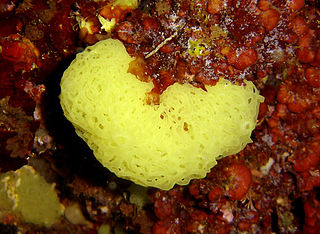
Clathrina is a genus of calcareous sponge in the family Clathrinidae. Several species formerly in Clathrina were transferred to the newly erected genera Arturia, Ernstia, Borojevia, and Brattegardia in 2013. The name is derived from the Latin word "clathratus" meaning "latticed".
Arturia africana is a species of calcareous sponge from South Africa.
Borojevia aspina is a species of calcareous sponge from Brazil. The species name refers to the lack of spines in the apical actine.
Borojevia brasiliensis is a species of calcareous sponge from Brazil, from which the species' name is derived.
Borojevia cerebrum is a species of calcareous sponge from the Mediterranean Sea. The species name refers to the brain-like appearance of the sponge.
Clathrina ceylonensis is a species of calcareous sponge from Sri Lanka. The species name is derived from Ceylon, the former name of Sri Lanka.
Clathrina chrysea is a species of calcareous sponge from New Caledonia. The species epithet refers to the light yellow colour of the sponge.
Clathrina cylindractina is a species of calcareous sponge from Brazil. The species is named after the cylindrical-shaped actines the sponge possesses.
Arturia dubia is a species of calcareous sponge in the genus Arturia from Australia. The species was first described as Leucosolenia dubia by Arthur Dendy in 1891. The name is derived from Dendy's uncertainty about the validity of the species, believing his specimens could, in fact, represent juvenile Leucosolenia cavata.
Ascaltis gardineri is a species of calcareous sponge in the family Leucascidae from India and the Seychelles. The species is named after the British zoologist John Stanley Gardiner.
Clathrina helveola is a species of calcareous sponge in the family Clathrinidae from Australia, found in coastal waters off Queensland. It was first described by Gert Wörheide and John Hooper in 1999. The species name, helveola, means "pale yellow" in Latin and refers to the species' colouration.
Arturia hirsuta is a species of calcareous sponge from South Africa. The name refers to the hispid surface of the sponge.
Clathrina hispanica is a species of calcareous sponge from Spain. The species is named after the country of Spain, where it was discovered.
Clathrina hondurensis is a species of calcareous sponge from Belize. The species is named for British Honduras, the former name of Belize, at the time the holotype was collected in 1935.
Clathrina luteoculcitella is a species of calcareous sponge from Australia. The species name means "yellow pillow" and refers to the appearance of the cormus.
Borojevia tetrapodifera is a species of calcareous sponge from New Zealand. The species is named after the presence of tetrapods, the only Clathrinid sponge known to possess such spicules.
Clathrina antofagastensis is a species of calcareous sponge from Chile. The species is named after Antofagasta, Chile, where the holotype was discovered.
Clathrina fjordica is a species of calcareous sponge from Chile. The species is named after Comau Fjord, the type locality.

Arturia is a genus of calcareous sponge in the family Clathrinidae which contains 14 species. It is named after Arthur Dendy, a prominent researcher of calcareous sponges. It was renamed Arturia in 2017 because the name Arthuria was already assigned to a genus of molluscs.
Borojevia is a genus of calcareous sponge in the family Clathrinidae. The genus is named after sponge researcher Radovan Borojevic.

